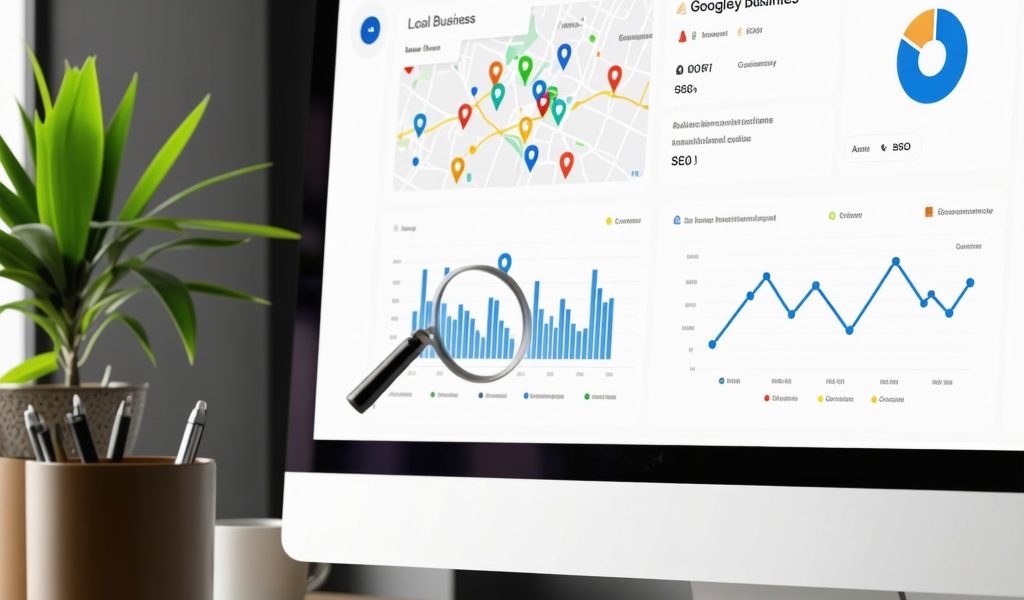Unlocking the Secrets Behind Your Google My Business Performance
Google My Business (GMB) has become the cornerstone of local SEO, transforming how businesses connect with nearby customers. But simply having a GMB profile isn’t enough — understanding how to track its performance and leverage data insights can be the difference between obscurity and local dominance. In this article, we delve deep into expert techniques for monitoring GMB metrics and strategically improving your local ranking, empowering your business to thrive in competitive local search landscapes.
Decoding GMB Metrics: Beyond the Surface-Level Numbers
Tracking GMB performance goes far beyond counting views or clicks. Key performance indicators such as search queries used to find your listing, customer actions (calls, direction requests, website visits), and photo engagement rates provide a multifaceted picture of how your business resonates locally. For example, analyzing which keywords drive the most map and search views can reveal hidden opportunities to refine your listing’s content and categories. This nuanced understanding enables tailored optimization that aligns with real user behavior.
How Can Advanced GMB Insights Propel Your Local Search Ranking?
Advanced GMB analytics, accessible through the Google Business Profile dashboard, reveal not only how often users find your business but also their intent. By identifying patterns in customer actions—such as spikes in direction requests correlating with promotional events—you can fine-tune your marketing strategies to convert interest into visits. Moreover, integrating GMB insights with tools like Google Analytics and Search Console provides a comprehensive ecosystem to pinpoint traffic sources and measure conversion funnels accurately. This holistic approach is essential for sustained local SEO success.
Practical Strategies to Enhance GMB Performance and Local Visibility
Based on real-world case studies, businesses that actively respond to reviews, keep their information up-to-date, and regularly post relevant content see measurable improvements in local rankings. For instance, updating your service offerings and hours promptly during seasonal shifts signals to Google that your business is active and reliable. Additionally, optimizing your GMB photos with descriptive filenames and alt text boosts user engagement and supports ranking factors. Leveraging citation consistency and local backlinks further reinforces your profile’s authority, creating a robust local SEO foundation.
Harnessing Data to Drive Continuous Local Growth
Tracking GMB performance is not a one-time task but an ongoing process of experimentation and refinement. Establishing benchmarks and regularly reviewing metrics enables you to identify what works and swiftly address areas needing improvement. For example, if you notice a decline in call actions, reevaluating your call-to-action phrases or updating your phone number format may help. Utilizing expert GMB citation services can also streamline consistency across platforms, enhancing trust signals and ranking potential.
Explore more about mastering your Google Business SEO with comprehensive guides like Mastering Google Business SEO: Your Complete Guide to elevate your local presence.
For further reading on optimizing your Google Business listing effectively, check out this detailed resource.
Ready to take your local SEO to the next level? Share your experiences or questions about tracking GMB performance in the comments below to join the conversation and learn from fellow local SEO professionals.
Authoritative insights referenced from Google’s official Business Profile Help and SEO industry leaders like Moz and Search Engine Journal highlight the critical role of comprehensive data analysis in local SEO strategies.
Reflecting on My Journey with GMB Performance Tracking
When I first started managing Google My Business profiles, I admit I was overwhelmed by the sheer volume of metrics available. It felt like trying to read a map in a foreign language. However, one breakthrough moment came when I noticed a consistent uptick in “direction requests” right after I updated the business hours during a holiday season. That small change, backed by data, confirmed how crucial it is to keep your GMB information current and relevant. It was like turning on a beacon for local customers.
This experience taught me that every data point on GMB tells a story — whether it’s a spike in photo views or a dip in website clicks. From there, I began to dive deeper into the behavioral patterns behind those numbers, adjusting listings and content accordingly. Today, I rely heavily on a mix of GMB insights and tools like Google Analytics to create an integrated, data-driven approach. This holistic view is essential to fine-tune local SEO strategies and stay ahead of the competition.
How Do You Know Which GMB Metrics Deserve Your Focus?
One of the most common questions I encounter is which GMB metrics should businesses prioritize. Honestly, it depends on your goals. For example, if your primary aim is foot traffic, then tracking “direction requests” and “calls” becomes critical. On the other hand, if your focus is online engagement, then metrics like website visits and photo interactions matter more.
What I’ve found particularly insightful is to watch for trends over time rather than fixating on day-to-day fluctuations. A steady increase in customer actions often signals that your optimization efforts are resonating, while sudden drops can be a red flag prompting immediate investigation. According to experts at Moz, emphasizing metrics that align with your business objectives can drive smarter decisions and better ROI in your local SEO campaigns (Moz Local Search Ranking Factors).
Personalizing GMB Optimization: Tailoring Your Approach
Every business I’ve worked with has unique local challenges. For a small cafe, responding promptly to reviews and sharing photos of daily specials boosted engagement dramatically. Meanwhile, a home services company benefited more from precise category selection and ensuring NAP (Name, Address, Phone number) consistency across citations.
Through trial and error, I’ve learned to customize optimization strategies based on the business type, competitive landscape, and customer behavior revealed through GMB data. This tailored approach avoids the “one-size-fits-all” pitfall and leads to more meaningful local visibility gains.
Have You Ever Wondered How Seasonal Changes Impact Your GMB Performance?
Seasonality can significantly influence GMB metrics, but many overlook it. For example, a landscaping business might see a natural dip in online searches during winter months, while an event planning service could experience peak interest in spring or summer. Tracking these fluctuations over years allows you to plan campaigns and updates strategically, maximizing visibility when demand is highest.
Integrating seasonal insights into your GMB management creates opportunities to proactively adapt your listings, post timely updates, and craft offers that resonate with local customers at the perfect moment.
If you want to explore more about optimizing your Google Business listing effectively, check out this detailed resource for actionable tips.
What GMB metrics have you found most helpful in your local SEO journey? Share your thoughts and experiences in the comments below — let’s learn from each other’s stories!
Seasonal Analytics and Predictive Adjustments: Elevating Your GMB Strategy to Expert Level
Understanding the intrinsic seasonality of your business through Google My Business metrics unlocks a sophisticated layer of local SEO that many overlook. Not merely tracking fluctuations, but employing predictive analytics to anticipate customer behaviors during peak and off-peak periods can revolutionize your local visibility. For example, integrating historic GMB data with external factors such as local events, weather patterns, and economic indicators enables precise timing for promotions and content updates, ensuring your listing remains relevant and compelling year-round.
Such an approach requires advanced data synthesis beyond basic GMB dashboards. Leveraging APIs and third-party analytics platforms to export and correlate GMB insights with CRM and sales data creates a feedback loop that informs marketing decisions at an institutional level. This methodology transforms GMB management from reactive maintenance into proactive growth engineering, where every metric guides strategic action.
Can Integrating External Data Sources with GMB Metrics Enhance Local SEO Performance?
Indeed, combining GMB metrics with external datasets is emerging as a best practice among local SEO experts. For instance, cross-referencing Google Trends data with your GMB search query performance can identify rising local interest in niche services before competitors catch on. Similarly, syncing weather forecasts with historical direction requests may predict customer foot traffic surges or lulls, allowing timely adjustments in staffing and inventory.
Industry studies, such as those published by the SEMrush Local SEO Trends Report, emphasize that businesses employing multi-source data integration see up to 30% higher engagement growth compared to those relying solely on GMB insights. This validates the strategic merit of weaving diverse data streams into your local SEO fabric.
Moreover, advanced segmentation of customer actions within GMB can isolate high-value behaviors, such as direction requests from premium ZIP codes or calls during promotional windows, enabling hyper-targeted campaigns. This granular approach is key to maximizing ROI in competitive local markets.
Automating GMB Optimization: Harnessing AI and Machine Learning for Dynamic Local SEO
Manual optimization, while essential, is increasingly insufficient given the velocity of local search dynamics. Enter AI-powered automation tools designed to monitor GMB performance continuously and execute optimization tasks autonomously. These platforms use machine learning algorithms to detect anomalies, forecast trends, and even generate localized content — all tailored to your unique business profile.
For example, AI can automate review responses with natural language processing that maintains brand voice authenticity, or adjust business hours dynamically based on predictive foot traffic models. This not only improves operational efficiency but also signals to Google that your profile is actively managed, which positively impacts ranking.
Integrating AI-driven insights with your existing SEO toolkit ensures you capitalize on real-time opportunities and mitigate risks promptly. It’s the vanguard of GMB management, merging human expertise with cutting-edge technology for unparalleled local SEO performance.
Ready to revolutionize your local SEO approach? Dive deeper into advanced GMB optimization techniques and AI integrations by subscribing to our expert newsletter and joining our upcoming webinar series.
Synergizing AI Innovations with Google My Business Optimization
As local search evolves at an unprecedented pace, the integration of artificial intelligence and machine learning into Google My Business (GMB) optimization is not merely advantageous but increasingly indispensable. By leveraging AI-driven platforms, businesses can transcend manual adjustments and adopt dynamic, data-responsive strategies that continuously refine listing performance. These intelligent systems analyze vast datasets, predict customer behaviors, and automate repetitive tasks such as review management and content updates, ensuring your GMB profile remains both current and compelling.
Advanced Data Fusion: Combining GMB Metrics with External Intelligence
Expert-level local SEO practitioners recognize that GMB insights alone provide an incomplete narrative of consumer engagement. The strategic fusion of GMB data with external analytics — including regional economic trends, competitive benchmarks, and social sentiment analysis — unlocks a multidimensional understanding of market dynamics. For example, correlating GMB search queries with localized social media trends can pinpoint emerging customer interests, allowing preemptive content creation that resonates authentically.
This multi-source data integration fosters a predictive optimization framework, enabling tailored marketing initiatives aligned with nuanced consumer preferences and temporal patterns. Industry leaders advocate this approach as foundational for maintaining a competitive edge in saturated local markets.

How Can Predictive Analytics Transform GMB Strategy for Hyperlocal Markets?
Predictive analytics, when applied to GMB metrics, empowers businesses to forecast demand fluctuations and customer behavior with remarkable precision. By analyzing historical GMB data alongside external variables such as local event calendars and climatic conditions, marketers can anticipate surges in foot traffic or online inquiries. This insight facilitates proactive inventory management, targeted promotions, and optimized staffing schedules.
Consequently, businesses can capitalize on temporal opportunities and mitigate downturns, thereby maximizing conversions and enhancing customer satisfaction. The deployment of predictive models transforms GMB management from reactive upkeep to strategic foresight.
For an authoritative perspective on advanced local SEO methodologies, the SEMrush Local SEO Trends Report offers comprehensive analysis and case studies illustrating the efficacy of integrated data strategies.
Embracing Continuous Innovation: The Path Forward in GMB Excellence
Mastering GMB optimization in today’s hypercompetitive landscape demands relentless innovation and agility. Businesses that harness AI automation coupled with sophisticated data integrations can orchestrate highly personalized customer experiences and sustain elevated local search rankings. This paradigm shift requires a commitment to ongoing learning, experimentation, and adaptation to emerging technologies.
Elevate your local SEO mastery by subscribing to our expert newsletter and securing your spot in our upcoming webinar series, where cutting-edge GMB optimization techniques and AI applications will be explored in depth. Engage with a community of professionals dedicated to pioneering local search excellence.
Frequently Asked Questions (FAQ)
What are the most important Google My Business metrics to monitor for local SEO success?
The key metrics include customer actions such as calls, direction requests, and website visits, as well as search queries driving traffic to your listing. Monitoring trends in these areas over time allows you to align optimization efforts with actual user behavior and business goals, whether that’s increasing foot traffic or online engagement.
How can integrating Google My Business data with external analytics enhance my local SEO strategy?
Combining GMB metrics with external data sources like Google Trends, local event calendars, weather patterns, and economic indicators enables predictive insights. This integration helps anticipate demand fluctuations, optimize promotional timing, and tailor localized marketing campaigns, resulting in more effective, data-driven decision-making.
Can AI and machine learning tools automate Google My Business optimization effectively?
Yes, AI-powered platforms can continuously monitor GMB performance, detect anomalies, forecast trends, and automate tasks such as review responses and content updates. This automation enhances operational efficiency and signals active profile management to Google, positively influencing local search rankings.
How does seasonality affect Google My Business performance, and how should I adapt?
Seasonal trends significantly impact search behavior and customer actions. By analyzing historical GMB data across seasons, businesses can schedule timely updates, promotions, and content that align with peak demand periods, ensuring sustained visibility and relevance throughout the year.
What role do customer reviews play in optimizing my Google My Business listing?
Responding promptly and thoughtfully to reviews builds trust and engagement, which Google interprets as a sign of an active and reputable business. Regular review management can improve rankings and influence potential customers’ perceptions positively.
How can I tailor my GMB optimization strategy to different types of businesses?
Optimization should be customized based on business type, competitive environment, and local customer behavior. For instance, a retail store may focus on photo engagement and promotions, while a service provider might prioritize accurate categories and NAP consistency. Data-driven insights from GMB metrics guide these tailored approaches.
Is it possible to predict local customer behavior using Google My Business data?
Through predictive analytics that combine historical GMB metrics with external factors, businesses can forecast customer demand, foot traffic, and engagement patterns. This capability enables proactive marketing and operational adjustments to maximize conversions and efficiency.
How often should I review and update my Google My Business listing?
Regular reviews are essential, ideally monthly or aligned with marketing campaigns and seasonal changes. Frequent updates signal to Google that your business is active, improving local search ranking and providing accurate information to customers.
What are the benefits of maintaining citation consistency across platforms?
Consistent Name, Address, and Phone number (NAP) citations across directories and listings build credibility and trust with search engines. This consistency strengthens your local SEO foundation and enhances your Google My Business profile’s authority.
Can combining GMB performance data with CRM and sales data improve marketing outcomes?
Yes, integrating GMB insights with CRM and sales systems creates a comprehensive feedback loop. This fusion allows businesses to correlate online engagement with actual sales and customer retention, refining targeting and resource allocation for superior ROI.
Trusted External Sources
Google Business Profile Help Center: The official resource for detailed guidelines, best practices, and updates directly from Google, ensuring accurate and authoritative information on managing and optimizing GMB listings.
Moz Local Search Ranking Factors Report: An industry-leading analysis that identifies key local SEO ranking signals and provides data-driven insights to help marketers prioritize optimization efforts effectively.
SEMrush Local SEO Trends Report: Offers comprehensive research on emerging local search trends, data integration techniques, and case studies illustrating advanced local SEO strategies including predictive analytics and AI applications.
Search Engine Journal (SEJ): A reputable publication featuring expert articles and tutorials on local SEO, GMB optimization, and the latest developments in search marketing technologies.
BrightLocal Local Consumer Review Survey: This survey provides valuable statistics and consumer behavior insights related to online reviews and local search, helping businesses understand the impact of reputation management on local SEO.
Conclusion: Elevate Your Local SEO with Data-Driven Google My Business Strategies
Mastering Google My Business performance tracking is crucial for businesses aiming to dominate local search landscapes. By moving beyond superficial metrics to embrace advanced analytics, predictive models, and AI-powered automation, you can transform your GMB listing into a dynamic asset that drives sustained customer engagement and conversions. Tailoring your optimization to your unique business context and integrating external data sources creates a comprehensive, proactive local SEO strategy that anticipates market shifts and customer needs.
Continuous innovation and commitment to data-driven refinement are the hallmarks of successful GMB management in today’s competitive environment. We encourage you to apply these expert insights, share your experiences, and explore further resources to unlock your business’s full local potential.
Ready to revolutionize your local presence? Share your thoughts, subscribe to expert updates, and dive deeper into advanced GMB optimization techniques today!


